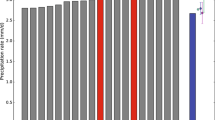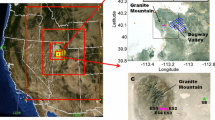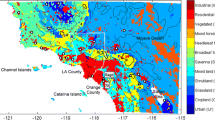Abstract
We investigate the cumulative added value of assimilating temperature, moisture, and wind observations in the three-dimensional non-hydrostatic Fifth-Generation Pennsylvania State University/National Center for Atmospheric Research Mesoscale Model MM5 and use these forecasts to analyze the relationship between surface forcing and planetary boundary-layer (PBL) depth. A data assimilation methodology focused on the surface and the PBL, previously tested in a one-dimensional version of MM5, is applied to 29 May, 6 June, and 7 June 2002 during the International \(\hbox {H}_{2}\hbox {O}\) Project over the Southern Great Plains. Model-predicted PBL depth is evaluated against PBL depth diagnosed from data across 4,800 km of airborne lidar data (flight tracks 100–300 km long). The forecast with data assimilation verifies better against observations and is thus used to investigate the environmental conditions that govern PBL depth. The spatial structure in PBL depth is found to be most affected by spatial variations in surface buoyancy flux and capping inversion strength. The spatial scales of surface flux forcing reflected in the PBL depth are found through Fourier analysis and multiresolution decomposition. Correlations are \({<}0.50\) at scales of 64 km or less and increase at larger scales for 29 May and 6 June, but on 7 June low correlations are found at all scales, possibly due to greater within-PBL wind speeds, a stronger capping inversion on this day, and clouds. The results suggest a minimum scale, a function of wind speed, below which heterogeneity in surface buoyancy fluxes is not reflected directly in PBL depth.














Similar content being viewed by others
References
Anderson MC, Norman JM, Mecikalski JR, Torn RD, Kustas WP, Basara JB (2004) A multiscale remote sensing model for disaggregating regional fluxes to micrometeorological scales. J Hydrometeorol 5:343–363
André JC, Bougeault P, Goutorbe J-P (1990) Regional estimates of heat and evaporation fluxes over non-homogenous terrain. Examples from the HAPEX-MOBILHY program. Boundary-Layer Meteorol 50:77–108
Barnes WL, Pagano TS, Salomonson VV (1998) Prelaunch characteristics of the moderate resolution imaging spectroradiometer (MODIS) on EOS-AM1. IEEE Trans Geosci Remote Sens 36:1088–1100
Behrendt A, Wulfmeyer V, Schaberl T, Bauer H-S, Kiemle C, Ehret G, Flamant C, Kooi S, Ismail S, Ferrare R, Browell EV, Whiteman DN (2007) Intercomparison of water vapor data measured with lidar during IHOP\_2002. Part II: Airborne-to-airborne systems. J Atmos Ocean Technol 24:22–39
Benjamin SG, Seaman NL (1985) A simple scheme for objective analyses in curved flow. Mon Weather Rev 113:1184–1198
Brown WOJ, Pinto JO, Yu TY, Parsons DB, Weckwerth T (2003) NCAR integrated sounding system observations at IHOP. In: 12th Symposium on meteorological observations and instrumentation, Long Beach, CA, USA, 10–13 February. American Meteorological Society, Boston, 10.4
Bruneau D, Quaglia P, Flamant C, Meissonnier M, Pelon J (2001) Airborne lidar LEANDRE II for water-vapor profiling in the troposphere. Appl Opt 40:3450–3475
Carlson TN, Benjamin SG, Forbes GS, Li Y-F (1983) Elevated mixed layers in the regional severe storm environment: conceptual model and case studies. Mon Weather Rev 111:1453–1473
Chen F, Avissar R (1994a) The impact of land-surface wetness heterogeneity on mesoscale heat fluxes. J Appl Meteorol 33:1323–1340
Chen F, Avissar R (1994b) Impact of land-surface variability on local shallow convective cumulus and precipitation in large-scale models. J Atmos Sci 23:1382–1401
Chen F, Dudhia J (2001) Coupling an advanced land surface—hydrology model with the Penn State—NCAR MM5 modeling system. Part I: Model implementation and sensitivity. Mon Weather Rev 129:569–585
Chen M, Huang X-Y (2006) Digital filter initialization for MM5. Mon Weather Rev 134:1222–1236
Chen F, Manning KW, Yates DN, LeMone MA, Trier SB, Cuenca R, Niyogi D (2004) Development of high resolution land data assimilation system and its application to WRF. In: Preprints of the 20th conference on weather analysis and forecasting/16th conference on numerical weather prediction, Seattle, WA, USA 22.3
Chen F, Manning KW, LeMone MA, Trier SB, Alfieri JG, Roberts R, Tewari M, Niyogi D, Horst TW, Oncley SP, Basara JB, Blanken PD (2007) Description and evaluation of the characteristics of the NCAR high-resolution land data assimilation system. J Appl Meteorol Clim 46:694–713
Conzemius R, Fedorovich E (2008) A case study of convective boundary layer development during IHOP\_2002: numerical simulations compared to observations. Mon Weather Rev 136:2305–2320
Couvreux F, Guichard F, Redelsperger J-L, Kiemle C, Masson V, Lafore J-P, Flamant C (2005) Water-vapour variability within a convective boundary-layer assessed by large-eddy simulations and IHOP\_2002 observations. Q J R Meteorol Soc 131:2665–2693
Couvreux F, Guichard F, Austin PH, Chen F (2009) Nature of the mesoscale boundary layer height and water vapor variability observed 14 June 2002 during the IHOP\_2002 campaign. Mon Weather Rev 137:414–432
Davis KJ, Gamage N, Hagelberg CR, Kiemle C, Lenschow DH, Sullivan PP (2000) An objective method for deriving atmospheric structure from airborne lidar observations. J Atmos Ocean Technol 17:1455–1468
Deng A, Stauffer DR (2006) On improving 4-km mesoscale model simulations. J Appl Meteorol Climatol 45:361–381
Deng A, Stauffer DR, Gaudet BJ, Dudhia J, Hacker J, Bruyere C, Wu W, Vandenberghe F, Liu F, Bourgeois A (2009) Update on WRF-ARW end-to-end multi-scale FDDA system. In: 10th Annual WRF users’ workshop, Boulder, CO, USA, NCAR, 1.9. http://www.mmm.ucar.edu/wrf/users/workshops/WS2009/WorkshopPapers.htm
Desai AR, Davis KJ, Senff CJ, Ismail S, Browell EV, Stauffer DR, Reen BP (2006) A case study on the effects of heterogeneous soil moisture on mesoscale boundary-layer structure in the Southern Great Plains, U.S.A. Part I: Simple prognostic model. Boundary-Layer Meteorol 119:195–238
Doran JC, Zhong S (1995) Variations in mixed-layer depths arising from inhomogeneous surface conditions. J Clim 8:1965–1973
Dudhia J (1993) A nonhydrostatic version of the Penn State—NCAR Mesoscale Model: validation tests and simulation of an Atlantic cyclone and cold front. Mon Weather Rev 121:1493–1513
Ek MB, Mitchell KE, Lin Y, Rogers E, Grunmann P, Koren V, Gayno G, Tarpley JD (2003) Implementation of Noah land surface model advances in the National Centers for Environmental Prediction operational mesoscale Eta model. J Geophys Res 108:8851. doi:10.1029/2002JD003296
Fensholt R, Sandholt I, Stisen S (2006) Evaluating MODIS, MERIS, and VEGETATION vegetation indices using in situ measurements in a semiarid environment. IEEE Trans Geosci Remote Sens 44(7):1774–1786
Fujita T, Stensrud DJ, Dowell DC (2007) Surface data assimilation using an ensemble Kalman filter approach with initial condition and model physics uncertainties. Mon Weather Rev 135:1846–1868
Giorgi F, Avissar R (1997) Representation of heterogeneity effects in earth system modeling: experience from land surface modelling. Rev Geophys 35:413–438
Grell GA, Dudhia J, Stauffer DR (1995) A description of the fifth-generation Penn State/NCAR Mesoscale Model (MM5), NCAR Technical Note NCAR/TN-398+STR, National Center for Atmospheric Research, Boulder, CO, USA, 122 pp. http://www.mmm.ucar.edu/mm5/doc1.html
Hayden CM (1973) Experiments in the four-dimensional assimilation of Nimbus 4 SIRS data. J Appl Meteorol 12:425–436
Holt TR, Niyogi D, Chen F, Manning K, LeMone MA, Qureshi A (2006) Effect of land–atmosphere interactions on the IHOP 24–25 May 2002 convection case. Mon Weather Rev 134:113–133
Howell JF, Mahrt L (1997) Multiresolution flux decomposition. Boundary-Layer Meteorol 83:117–137
Janjić ZI (2001) Nonsingular implementation of the Mellor–Yamada level 2.5 scheme in the NCEP meso model, NCEP Office Note 437, 61 pp. http://www.emc.ncep.noaa.gov/officenotes/FullTOC.html
Kain JS, Fritsch JM (1990) A one-dimensional entraining/detraining plume model. J Atmos Sci 47:2784–2802
Kang S-L, Davis KJ (2008) The effects of mesoscale surface heterogeneity on the fair-weather convective atmospheric boundary layer. J Atmos Sci 65:3197–3213
Kang S-L, Davis KJ, LeMone M (2007) Observations of ABL structures over a heterogeneous land surface during IHOP\_2002. J Hydrometeorol 8:221–244
Kiemle C, Brewer WA, Ehret G, Hardesty RM, Fix A, Senff C, Wirth M, Poberaj G, LeMone MA (2007) Latent heat flux profiles from collocated airborne water vapor and wind lidars during IHOP\_2002. J Atmos Ocean Technol 24:627–639. doi:10.1175/JTECH1997.1
Lanicci JM, Carlson TN, Warner TT (1987) Sensitivity of the Great Plains severe-storm environment to soil-moisture distribution. Mon Weather Rev 115:2660–2673
Lei L, Stauffer DR, Deng A (2012) A hybrid nudging-ensemble Kalman filter approach to data assimilation in WRF/DART. Q J R Meteorol Soc. doi:10.1002/qj.1939
LeMone MA, Grossman RL, Coulter RL, Wesley ML, Klazura GE, Poulos GS, Blumen W, Lundquist JK, Cuenca RH, Kelly SF, Brandes EA, Oncley SP, McMillen RT, Hicks BB (2002) CASES-97: late-morning warming and moistening of the convective boundary layer over the Walnut River watershed. Boundary-Layer Meteorol 104:1–52
LeMone MA, Chen F, Alfieri JG, Cuenca RH, Hagimoto Y, Blanken P, Niyogi D, Kang S, Davis K, Grossman RL (2007a) NCAR/CU surface, soil, and vegetation observations during the International H2O Project 2002 field campaign. Bull Am Meteorol Soc 88:65–81
LeMone MA, Chen F, Alfieri JG, Tewari M, Geerts B, Miao Q, Grossman RL, Coulter RL (2007b) Influence of land cover and soil moisture on the horizontal distribution of sensible and latent heat fluxes in Southeast Kansas during IHOP\_2002 and CASES-97. J Hydrometeorol 8:68–87
LeMone MA, Chen F, Tewari M, Dudhia J, Geerts N, Miao Q, Coulter RL, Grossman RL (2010a) Simulating the IHOP\_2002 fair-weather CBL with the WRF-ARW-Noah modeling system. Part I: Surface fluxes and CBL structure and evolution along the eastern track. Mon Weather Rev 138:722–744
LeMone MA, Chen F, Tewari M, Dudhia J, Geerts N, Miao Q, Coulter RL, Grossman RL (2010b) Simulating the IHOP\_2002 fair-weather CBL with the WRF-ARW-Noah modeling system. Part II: Structures from a few kilometers to 100 km across. Mon Weather Rev 138:745–764
Lynn BH, Rind D, Avissar R (1995) The importance of mesoscale circulations generated by subgrid-scale landscape heterogeneities in general circulation models. J Clim 8:191–205
Lynn BH, Tao W-K, Wetzel PJ (1998) A study of landscape-generated deep moist convection. Mon Weather Rev 126:928–942
Mahrt L (2000) Surface heterogeneity and vertical structure of the boundary layer. Boundary-Layer Meteorol 96:33–62
Mahrt L, Sun J, Vickers D, MacPherson JI, Pederson JR, Desjardins RJ (1994) Observation of fluxes and inland breezes over a heterogeneous surface. J Atmos Sci 51:2184–2499
Manning, KW, Haagenson PL (1992) Data ingest and objective analysis for the PSU/NCAR modeling system: programs DATAGRID and RAWINS. NCAR Technical Note NCAR/TN-376+IA, National Center for Atmospheric Research, Boulder, CO, USA, 209 pp. http://www.mmm.ucar.edu/mm5/doc1.html
Margulis SA, Entekhabi D (2001) Feedback between the land surface energy balance and atmospheric boundary layer diagnosed through a model and its adjoint. J Hydrometeorol 2:599–620
McCumber MC, Pielke RA (1981) Simulation of the effects of surface fluxes of heat and moisture in a mesoscale numerical model. Part 1: Soil layer. J Geophys Res 86:9929–9938
Mlawer EJ, Taubman SJ, Brown PD, Iacono MJ, Clough SA (1997) Radiative transfer for inhomogeneous atmospheres: RRTM, a validated correlated-k model for the longwave. J Geophys Res 102(D14):16663–16682
Modica GD, Yee SY-K, Venuti J (1992) Some effects of soil and vegetation databases on spectra of limited-area mesoscale simulations. Mon Weather Rev 120:2067–2082
Niyogi DS, Raman S, Alapaty K (1999) Uncertainty in the specification of surface characteristics. Part II: Hierarchy of interaction-explicit statistical analysis. Boundary-Layer Meteorol 91:341–366
Poberaj G, Fix A, Assion A, Wirth M, Kiemle C, Ehret G (2002) Airborne all-solid-state DIAL for water vapour measurements in the tropopause region: system description and assessment of accuracy. Appl Phys B75:165–172
Ramamurthy MK, Carr FH (1987) Four-dimensional data assimilation in the monsoon region. Part I: Experiments with wind data. Mon Weather Rev 115:1678–1706
Reen BP, Stauffer DR (2010) Data assimilation strategies in the planetary boundary layer. Boundary-Layer Meteorol 137:237–269. doi:10.1007/s10546-010-9528-6
Reen BP, Stauffer DR, Davis KJ, Desai AR (2006) A case study on the effects of heterogeneous soil moisture on mesoscale boundary-layer structure in the Southern Great Plains, U.S.A. Part II: Mesoscale modelling. Boundary-Layer Meteorol 120:275–314
Ruggiero FH, Modica GD, Lipton AE (2000) Assimilation of satellite imager data and surface observations to improve analysis of circulations forced by cloud shading contrasts. Mon Weather Rev 128:434–448
Rust WD, Davies-Jones R, Burgess D, Maddox R, Showell L, Marshall T, Lauritsen D (1990) Testing a mobile version of a cross-chain Loran atmospheric sounding system (M-CLASS). Bull Am Meteorol Soc 71:173–180
Seaman NL, Stauffer DR, Lario-Gibbs AM (1995) A multiscale four-dimensional data assimilation system applied in the San Joaquin Valley during SARMAP. Part I: Modeling design and basic performance characteristics. J Appl Meteorol 34:1739–1761
Shafran PC, Seaman NL, Gayno GA (2000) Evaluation of numerical predictions of boundary layer structure during the Lake Michigan Ozone Study. J Appl Meteorol 39:412–426
Skamarock WC, Klemp JB, Dudhia J, Gill DO, Barker DM, Duda MG, Huang X-Y, Wang W, Powers JG (2008) A description of the advanced research WRF version 3, NCAR Technical Note NCAR/TN-475+STR, National Center for Atmospheric Sciences, Boulder, CO, USA, 125 pp
Stauffer DR, Seaman NL (1990) Use of four-dimensional data assimilation in a limited-area mesoscale model. Part I: Experiments with synoptic-scale data. Mon Weather Rev 118:1250–1277
Stauffer DR, Seaman NL (1994) Multiscale four-dimensional data assimilation. J Appl Meteorol 33:416–434
Stauffer DR, Seaman NL, Binkowski FS (1991) Use of four-dimensional data assimilation in a limited-area mesoscale model. Part II: Effects of data assimilation within the planetary boundary layer. Mon Weather Rev 119:734–754
Stauffer DR, Muñoz RC, Seaman NL (1999) In-cloud turbulence and explicit microphysics in the MM5. In: Proceedings of the ninth PSU/NCAR MM5 model users’ workshop, Boulder, CO, USA, NCAR, pp 177–180
Stoica P, Moses R (2005) Spectral analysis of signals. Pearson Prentice Hall, Upper Saddle River, 452 pp
Trier SB, Chen F, Manning KW (2004) A study of convection initiation in a mesoscale model using high-resolution land surface initial conditions. Mon Weather Rev 132:2954–2976
Vickers D, Mahrt L (2003) The cospectral gap and turbulent flux calculations. J Atmos Ocean Technol 20:660–672
Weckwerth TM, Parsons DB, Koch SE, Moore JA, LeMone MA, Demoz BB, Flamant C, Geerts B, Wang J, Feltz WF (2004) An overview of the International H2O Project (IHOP\_2002) and some preliminary highlights. Bull Am Meteorol Soc 85:253–277
Yi C, Davis KJ, Berger BW (2001) Long-term observations of the dynamics of the continental planetary boundary layer. J Atmos Sci 58:1288–1299
Zhang D, Anthes RA (1982) A high-resolution model of the planetary boundary layer—sensitivity tests and comparisons with SESAME-79 data. J Appl Meteorol 21:1594–1607
Ziegler CL, Kennedy D, Rasmussen EN (2004) A Wireless network for collection and synthesis of mobile mesoscale weather observations. J Atmos Ocean Technol 21:1659–1670
Acknowledgments
Cyrille Flamant of Laboratoire Atmosphère, Milieux, Observations Spatiales, CNRS, and Université Pierre et Marie Curie, Paris, France, and colleagues from there and the Technical Division of the Institut National des Sciences de l’Univers (Jacques Pelon, Didier Bruneau, Fredéric Blouzon, Abdel Abchiche, Patricia Delville, Nadir Amarouche) are acknowledged for provision of LEANDRE II lidar data, Gerhard Ehret, Christoph Kiemle, and colleagues for DLR Differential Absorption Lidar data, Ken Craig for lidar-derived PBL depth, Fei Chen and Kevin Manning for High Resolution Land Data Assimilation System output, and Ricardo Muñoz for the 1D Matlab GUI version of MM5 and the code used to create the skew-T diagram. In addition to the co-authors, Toby Carlson and Chris Duffy are acknowledged for participation on the PhD committee of the first author. George Young provided helpful guidance in interpreting results. Some data were obtained from the Atmospheric Radiation Measurement Program sponsored by the U.S. Department of Energy or from NCAR/EOL under sponsorship of the National Science Foundation. We acknowledge the efforts of three anonymous reviewers that led to improvements in this manuscript. This research was supported by National Science Foundation Grant ATM-0130349, the U.S. Defense Threat Reduction Agency through W911NF-06-1-0439 under the supervision of John Hannan, and the U.S. Defense Threat Reduction Agency through HDTRA1-10-1-0033 under the supervision of John Hannan and Anthony Esposito.
Author information
Authors and Affiliations
Corresponding author
Rights and permissions
About this article
Cite this article
Reen, B.P., Stauffer, D.R. & Davis, K.J. Land-Surface Heterogeneity Effects in the Planetary Boundary Layer. Boundary-Layer Meteorol 150, 1–31 (2014). https://doi.org/10.1007/s10546-013-9860-8
Received:
Accepted:
Published:
Issue Date:
DOI: https://doi.org/10.1007/s10546-013-9860-8




